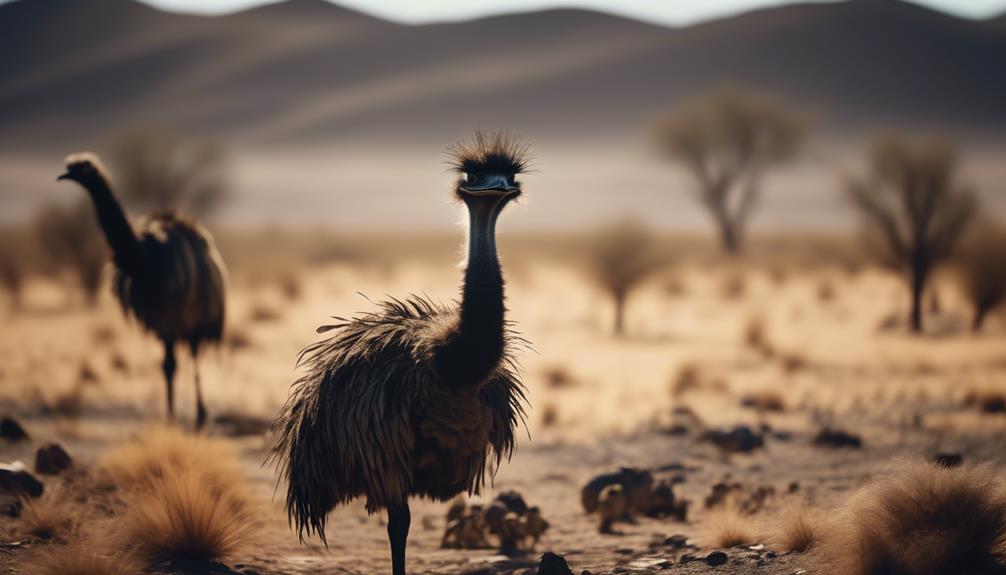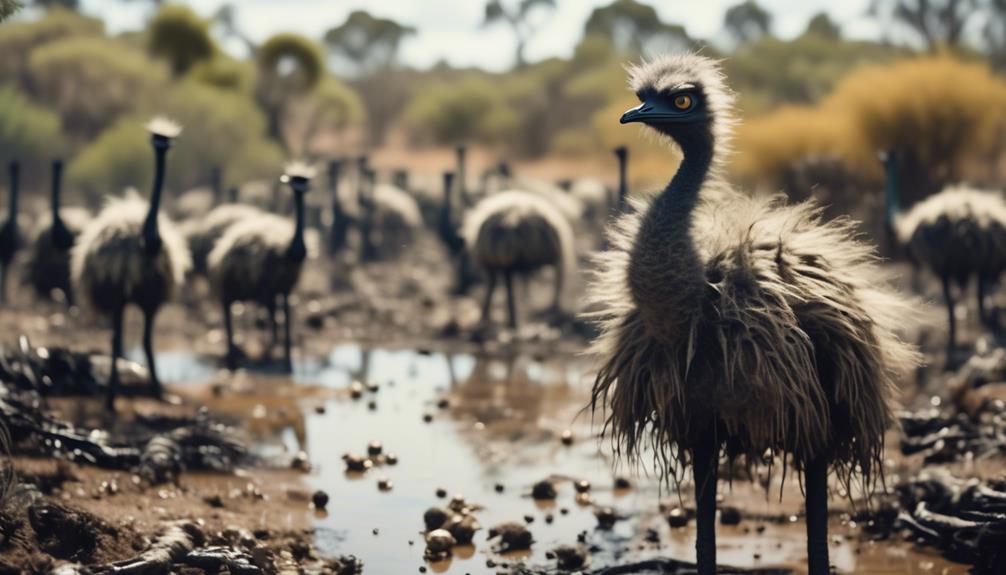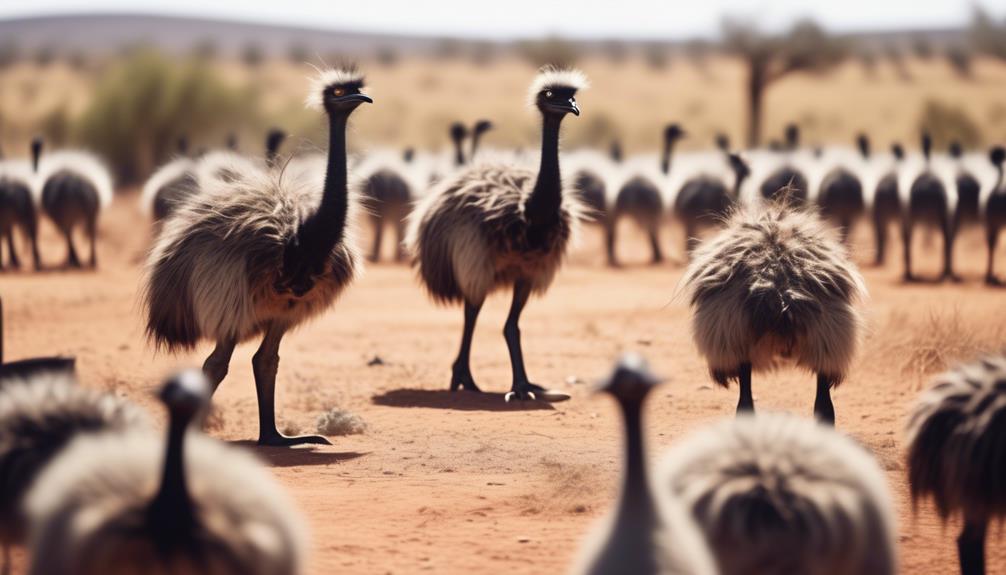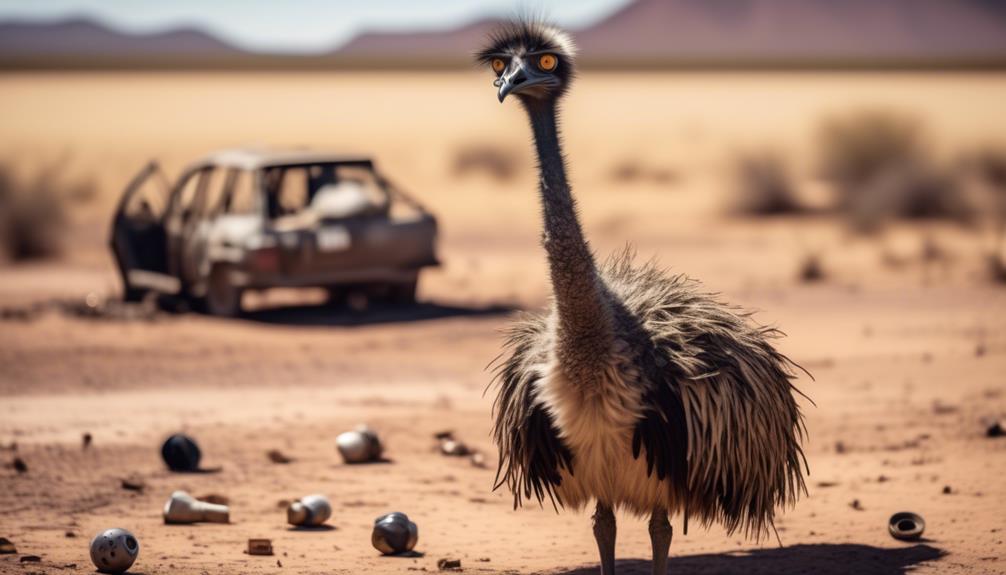
As you ponder the vast expanse of the Australian outback, it may come as a surprise that human activity has had a significant impact on the populations of the iconic emu.
From habitat destruction to overhunting, a multitude of factors have contributed to the decline of these majestic birds. But what exactly are these factors, and how do they affect emu populations?
Let's explore the intricate web of human influence and its consequences for these fascinating creatures.
Key Takeaways
- Habitat destruction and fragmentation, caused by activities such as deforestation and clearing of vegetation, have led to a decline in emu populations and quality of their habitats.
- Overhunting and poaching for their meat, feathers, and eggs have significantly decreased emu populations and disrupted the ecological balance.
- Road accidents and collisions pose a threat to emu populations, and implementing road safety measures and wildlife crossings can help reduce the number of accidents.
- Pollution and contamination from air and water sources directly affect emus, disrupting their natural behaviors and interactions with the environment while also weakening their immune systems and reproductive success.
Habitat Destruction
Habitat destruction significantly impacts emu populations, leading to a decline in their numbers and overall habitat quality. Negative consequences arise from the destruction of emu habitats, resulting in an environmental imbalance. As human activity expands, habitats that once provided essential resources for emus are being destroyed at an alarming rate.
Emus are highly adaptable birds, but they rely on specific habitats for nesting, foraging, and breeding. When these habitats are destroyed, emu populations suffer. The clearing of vegetation and deforestation leave emus vulnerable to predation and limit their access to food and water sources. As a result, their numbers dwindle, affecting the overall balance of the ecosystem.
Evidence shows that habitat destruction has a direct correlation with the decline in emu populations. Studies conducted in areas where habitat destruction has occurred demonstrate a significant decrease in emu sightings and breeding success. The loss of suitable habitat also disrupts the natural interactions between emus and other species, leading to a disturbance in the ecological equilibrium.
To mitigate the negative consequences of habitat destruction, conservation efforts must focus on preserving and restoring emu habitats. This includes implementing sustainable land management practices, protecting critical areas, and promoting habitat connectivity. Only through these measures can we restore the environmental balance and ensure the long-term survival of emu populations.
Fragmentation of Emu Habitats
Fragmentation of emu habitats has resulted in significant consequences for their survival and ecological interactions. Habitat degradation and the loss of biodiversity are two key issues that arise from this fragmentation. Let's take a closer look at how these factors affect emus and their habitats.
| Factors | Impact | Examples |
|---|---|---|
| Habitat degradation | – Reduction in suitable nesting and foraging areas<br>- Decline in availability of resources such as food and water<br>- Increased competition among emus | – Conversion of natural habitats into agricultural or urban areas<br>- Overgrazing by livestock<br>- Introduction of invasive species disrupting native ecosystems |
| Loss of biodiversity | – Disruption of ecological interactions and processes<br>- Decline in species richness and abundance<br>- Increased vulnerability to diseases and predation | – Fragmentation isolating populations and limiting gene flow<br>- Extinction of plant and animal species due to habitat loss<br>- Predation by introduced predators due to reduced habitat connectivity |
The fragmentation of emu habitats not only affects emus themselves but also has far-reaching consequences for the entire ecosystem. As emus rely on intact habitats for nesting, foraging, and social interactions, the degradation of their habitat disrupts their natural behaviors and can lead to population decline. Additionally, the loss of biodiversity resulting from fragmentation hampers the functioning of ecological processes, reducing the resilience of the ecosystem as a whole.
To ensure the long-term survival of emu populations and maintain the ecological balance, it is crucial to address the fragmentation of their habitats. This requires implementing conservation strategies that focus on habitat restoration, connectivity enhancement, and the protection of critical areas. By protecting and restoring emu habitats, we can mitigate the negative impacts of fragmentation and safeguard the future of these iconic birds and the biodiversity they support.
Overhunting and Poaching

The detrimental effects of human activity on emu populations extend beyond habitat fragmentation, as overhunting and poaching pose significant threats to their survival and ecological balance. These illegal practices have contributed to a rapid decline in emu populations, endangering their long-term survival.
Here are three key aspects to consider regarding overhunting and poaching:
- Illegal Trade: Emus are prized for their meat, feathers, and eggs, making them targets for illegal trade. The demand for these products has fueled a black market, where emus are hunted and traded without legal oversight. This unregulated trade further exacerbates the decline in emu populations.
- Population Decline: Overhunting and poaching have resulted in a significant decrease in emu numbers. With emus being targeted for their valuable resources, their populations have been unable to recover at a sustainable rate. This decline threatens the ecological balance of their habitats and disrupts the natural food chain.
- Environmental Impact: The decline of emu populations also has broader ecological consequences. Emus play a crucial role in seed dispersal and vegetation control. Their absence disrupts these vital processes, leading to imbalances in the ecosystem and potentially affecting other species.
Addressing overhunting and poaching is crucial for the preservation of emu populations. Strict enforcement of laws against illegal trade, increased surveillance, and community education are essential steps in protecting these iconic birds from further harm.
Road Accidents and Collisions
Road accidents and collisions pose a significant threat to emu populations, impacting their survival and contributing to population decline. As human populations continue to expand, the construction of roads and highways has become a common occurrence. Unfortunately, these infrastructures often intersect with emu habitats, leading to an increased risk of accidents and collisions. The consequences of these incidents are severe, resulting in injuries and fatalities for both emus and humans.
To address this issue and mitigate the impact on emu populations, road safety measures and wildlife crossing solutions are crucial. Implementing wildlife crossing signs and speed restrictions in areas with high emu activity can help raise awareness and reduce the likelihood of collisions. Additionally, constructing wildlife underpasses or overpasses can provide safe passage for emus and other wildlife, allowing them to navigate across roads without risking their lives.
Scientific data supports the effectiveness of these measures in reducing road accidents involving emus. Studies have shown that wildlife crossings significantly decrease the number of collisions, protecting both the emus and motorists. Furthermore, these solutions promote coexistence between humans and emus, ensuring the long-term survival of this iconic species.
Pollution and Contamination

Pollution and contamination pose a significant threat to the well-being and survival of emu populations. The negative impact of human activities on the environment has led to various forms of pollution and contamination that directly affect these birds. Here are three key points to consider:
- Health effects: Emus are highly sensitive to pollution and contamination, as their respiratory systems are particularly vulnerable. Air pollution from industrial emissions, vehicle exhaust, and agricultural activities can lead to respiratory problems and reduced lung function in emus. Additionally, water pollution caused by chemical runoff from agriculture and industrial waste can contaminate their drinking water sources, leading to gastrointestinal issues and impaired overall health.
- Ecosystem disruption: Emus play a vital role in their ecosystems as seed dispersers and foragers. Pollution and contamination can disrupt their natural behaviors and interactions with their environment. For example, exposure to toxic chemicals can result in emus consuming contaminated food sources, which can then lead to negative effects on other species within the ecosystem. This disruption can have far-reaching consequences, impacting the overall health and biodiversity of the ecosystem.
- Long-term consequences: The cumulative effects of pollution and contamination can have long-lasting consequences on emu populations. Chronic exposure to pollutants can weaken their immune systems, making them more susceptible to diseases and reducing their reproductive success. Over time, this can result in a decline in emu numbers, jeopardizing the sustainability of their populations.
It is crucial to address pollution and contamination to ensure the well-being and survival of emu populations. Implementing measures to reduce industrial emissions, promoting sustainable farming practices, and raising awareness about the importance of preserving natural habitats are essential steps toward protecting these magnificent birds and the ecosystems they inhabit.
Climate Change Effects
Emu populations aren't only threatened by pollution and contamination but also face significant challenges due to the effects of climate change. Climate change can have profound impacts on the reproductive behavior of emus and lead to shifts in their migration patterns.
One of the key effects of climate change on emu populations is the disruption of their reproductive behavior. Rising temperatures and changes in precipitation patterns can alter the timing of breeding seasons and affect the availability of food resources. This can result in reduced reproductive success and lower overall population growth.
Additionally, climate change can cause shifts in emu migration patterns. Emus are known to move in search of food, water, and suitable breeding grounds. However, changes in temperature and rainfall patterns can alter the distribution of these resources, forcing emus to adapt their migration routes. This can lead to increased competition for limited resources and potential conflicts with human activities.
Understanding the impacts of climate change on emu populations is crucial for their conservation and management. By studying their reproductive behavior and migration patterns in the context of changing climatic conditions, scientists can develop strategies to mitigate the negative effects and ensure the long-term survival of these iconic birds.
Competition With Livestock

The competition between emu populations and livestock can have significant implications for the conservation and management of these iconic birds. Livestock impact on emus is a complex issue that requires careful consideration. Here are three key points to help you understand the grazing competition between emus and livestock:
- Resource competition: Emus and livestock often rely on the same food sources, such as grasses and plants. As a result, when livestock graze in an area, they reduce the available resources for emus. This can lead to decreased food availability and increased competition for limited resources.
- Habitat alteration: Livestock grazing can also lead to habitat alteration, which can negatively impact emu populations. Overgrazing by livestock can result in the loss of vegetation cover, reducing the availability of suitable nesting sites and shelter for emus. This can disrupt their breeding and survival patterns.
- Disease transmission: Livestock can act as reservoirs for various diseases that may be transmitted to emus. For example, certain parasites and pathogens carried by livestock can infect emus, leading to increased mortality rates and decreased population numbers.
Understanding the impact of livestock on emu populations is crucial for effective conservation and management strategies. By carefully managing grazing practices and implementing measures to minimize competition, we can help ensure the long-term survival of these magnificent birds.
Introduction of Invasive Species
Introduction of invasive species can have significant negative effects on ecosystems and biodiversity. When non-native species are introduced into an ecosystem, they can disrupt the delicate ecological balance that has developed over time. The negative consequences of invasive species can be devastating, impacting not only native species but also the overall functioning of the ecosystem.
Invasive species often outcompete native species for resources such as food, water, and habitat. They can quickly reproduce and spread, overpowering native species and causing a decline in their populations. This competition for resources can lead to reduced biodiversity and a loss of native species, which are essential for maintaining ecological balance.
In addition to competition, invasive species can also disrupt natural processes within an ecosystem. They may prey upon native species, leading to their decline or even extinction. They can also alter the physical characteristics of habitats, making them unsuitable for native species. These disruptions can have cascading effects throughout the ecosystem, affecting multiple trophic levels and ultimately leading to a loss of biodiversity.
To mitigate the negative impacts of invasive species, it's crucial to implement effective management and control strategies. This involves monitoring and early detection of invasive species, as well as implementing measures to prevent their introduction and spread. By addressing the issue of invasive species, we can protect and restore ecological balance, ensuring the preservation of biodiversity for future generations.
Lack of Conservation Efforts

In order to effectively address the negative impacts of invasive species on ecosystems and biodiversity, it's essential to acknowledge the pressing issue of inadequate conservation efforts. Despite the urgency of the situation, current conservation policies have proven to be ineffective in curbing the decline of Emu populations. This lack of action stems from human indifference towards the plight of these magnificent birds.
To further understand the gravity of the situation, consider the following three key points:
- Ineffective policies: The existing conservation policies fail to provide adequate protection to Emu populations. They lack the necessary measures to mitigate the threats posed by human activities such as habitat destruction and fragmentation, hunting, and climate change. Without proper safeguards, Emus continue to face a precarious future.
- Human indifference: The lack of public awareness and concern for Emu conservation exacerbates the problem. Many individuals remain unaware of the critical role Emus play in maintaining ecosystem balance. This indifference hampers efforts to mobilize resources and support for conservation initiatives.
- Urgent need for action: The decline of Emu populations demands immediate action. Without concerted efforts to protect their habitats, regulate hunting practices, and raise public awareness, these iconic birds may face irreversible decline or even extinction.
Addressing the issue of inadequate conservation efforts necessitates reevaluating current policies, raising awareness, and fostering a sense of responsibility towards Emu conservation. The future of these unique and vital creatures relies on our collective action to protect and preserve their habitats.
Frequently Asked Questions
How Do Emus Contribute to the Ecosystem?
Emus contribute to the ecosystem through their ecological role. Emu conservation efforts are crucial for maintaining biodiversity and ecosystem balance. They aid in seed dispersal, control insect populations, and provide habitat for other species.
What Are the Natural Predators of Emus?
Emus, like many animals, face predation in their natural habitats. Understanding their natural predators is crucial for effective emu conservation efforts. Identifying and mitigating threats can help protect emu populations and maintain a balanced ecosystem.
Can Emus Adapt to New Habitats?
Emus can adapt to new habitats, but human activity, such as habitat loss and migration interference, poses challenges. Understanding the impact of these factors is crucial for conserving emu populations and ensuring their survival.
Are There Any Efforts to Relocate Emus to Safer Areas?
Efforts to protect emu populations and conserve their habitats are underway. Emus are being relocated to safer areas to ensure their survival. These initiatives aim to mitigate the impact of human activity on emu populations.
How Do Emu Populations Compare to Other Bird Species?
Emu populations, when compared to other bird species, show a unique ecological significance. Comparative analysis reveals their distinct characteristics and behaviors, shedding light on their role in the ecosystem.
Conclusion
In conclusion, the impact of human activity on emu populations is undeniable.
Habitat destruction, fragmentation, overhunting, road accidents, pollution, climate change, competition with livestock, introduction of invasive species, and lack of conservation efforts have all taken a toll on these majestic birds.
The need for immediate action and stronger conservation efforts is evident, as we strive to preserve the delicate balance of our ecosystems and protect the future of the emu population.


